Following are the most common foliage problems of tomatoes in the lower Midwest and the noteworthy symptoms of each problem. Use this guide as an aid to help you distinguish between the symptoms of each problem. Click the images to enlarge them. Click the links (colored text) for more detailed information, control measures and more images. Common lookalikes are also included.
|
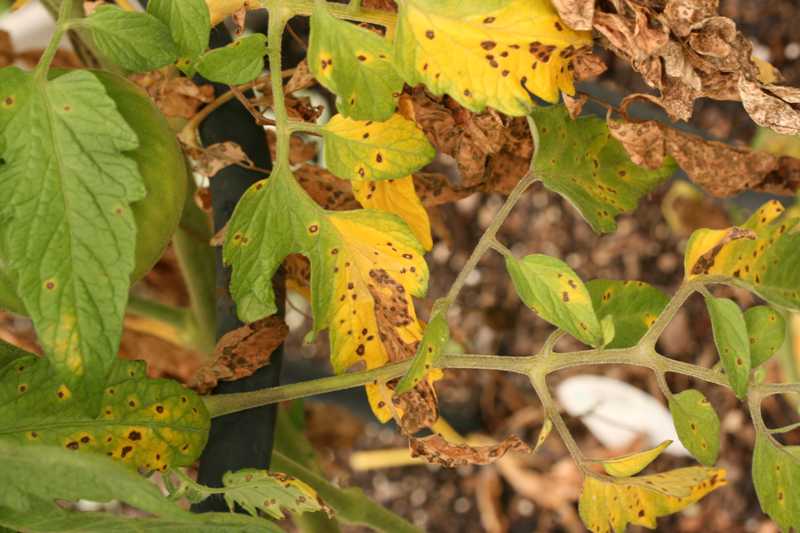 |
Disease prevention
This guide lists the most common foliar problems of tomatoes (for problems on fruit, see our Visual Guide: Tomato Fruit Problems), but preventing problems is usually easier than curing them. So, here are ten strategies to help prevent diseases and other problems:
1. Although many heirloom varieties have better flavor than newer varieties, they lack disease resistance. Purchasing disease resistant cultivars can help, but keep in mind that disease resistance does not mean immunity. Preventive strategies are still important.
2. Disinfect tools, tomato cages and stakes with a solution of one part bleach to nine parts water.
3. Rotate the planting location every three to five years.
4. Do not plant in cold soils. This weakens plants making them more susceptible to diseases and may stunt them permanently.
5. Do not crowd tomatoes. Good air circulation around plants is vital in keeping the foliage dry and preventing diseases.
6. Remove lower branches, leaving the stem bare up to the first set of flowers and then mulch (straw is a good choice). Many fungal diseases are in the soil or in bits of plant material left over from previous years. When it rains, fungal spores splash up onto the lower leaves, infecting them. The next time it rains, the spores from the infected leaves splash up onto the next set of leaves. Unchecked the infection will spread all the way to the top of the plant.
7. Water in the morning to give the foliage time to dry out before nightfall.
8. Remove any diseased looking leaves as soon as possible.
9. If a spray program becomes necessary, use a fungicide (such as, chlorothalonil) alternated with a copper based fungicide to help with bacterial diseases because even an expert can have difficulty distinguishing between fungal diseases and bacterial diseases. Note: fungicides do not cure fungal diseases; they can only prevent them from spreading.
10. At the end of every growing season, remove as much of the plant as possible from the garden and do not compost.
For more information about care and culture of tomatoes, including fertilizing, see our Kemper Factsheet: Tomatoes. For more information about tomato problems, see our Kemper Factsheet Tomato Diseases and Disorders. |
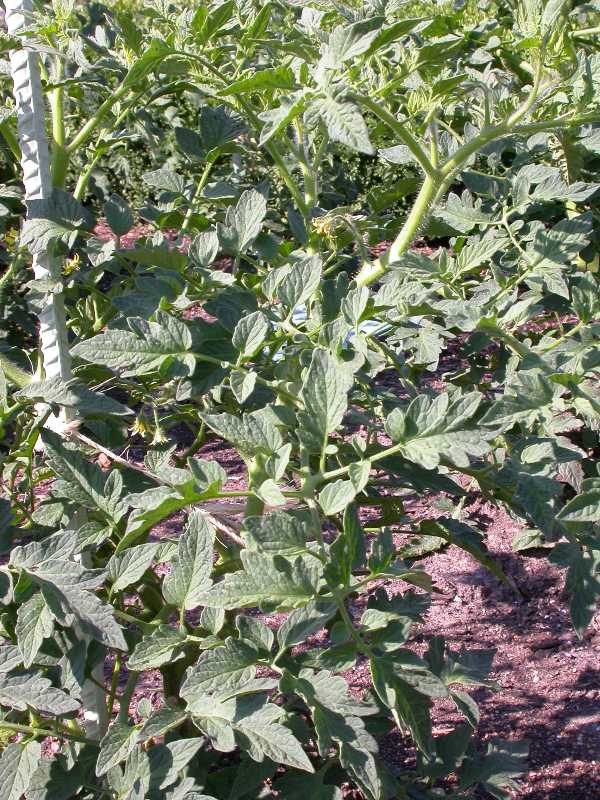 |
Failure to set fruit or poor fruit set
1. Night temperatures above 70 degrees or below 55 degrees.
2. Day temperatures above 90 degrees combined with low humidity and/or drought. Hot drying winds can add to the problem.
3. Dry soil can cause blossoms to dry up and drop.
4. Too much nitrogen fertilizer produces leafy growth at the expense of flowers and fruit.
5. Cold soils at planting time can stunt growth and delay or eliminate flowering.
6. Insufficient light. Tomatoes require at least 6 hours of direct sunlight per day.
7. Viruses, such as, curly top, mosaic viruses, etc., can affect flowering and fruit set.
8. Lack of air circulation can inhibit the movement of pollen to the flower pistils. |
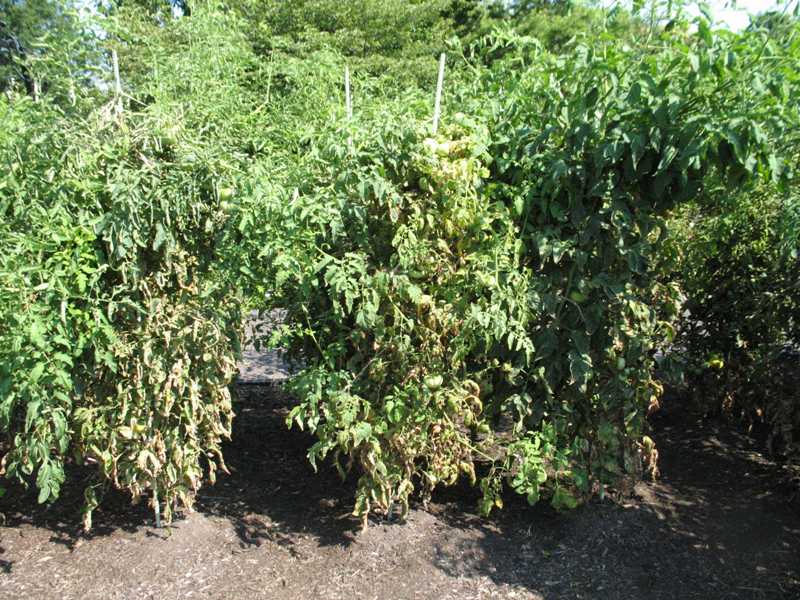 |
Lack of air circulation
Crowding tomatoes can encourage moisture loving fungal diseases by blocking air circulation and keeping the foliage from drying out properly. It can also reduce fruit production by inhibiting the movement of pollen to the flower pistils. This movement is usually accomplished by insects or by wind shaking the pollen inside the flowers. Maintain good air circulation by planting tomatoes at least 3 to 4 feet apart in each direction and more distance would be better. |
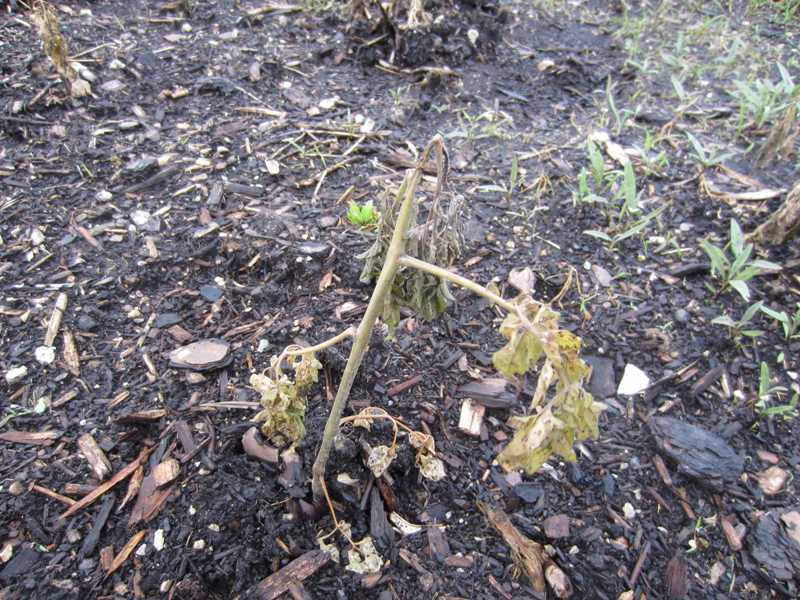 |
Cold soils
Planting tomatoes in cold soil may cause the leaves to turn purple from a lack of potassium because tomatoes cannot absorb potassium if the soil is too cold. The leaves will usually green up as the soil warms, but the plants may be stunted for the entire growing season and produce few or no fruit. Planting them too early also exposes to the risk of a late spring freeze that can kill the entire plant (pictured).
Lookalikes: Some tomatoes varieties have naturally purplish foliage; viral diseases can cause stunting. |
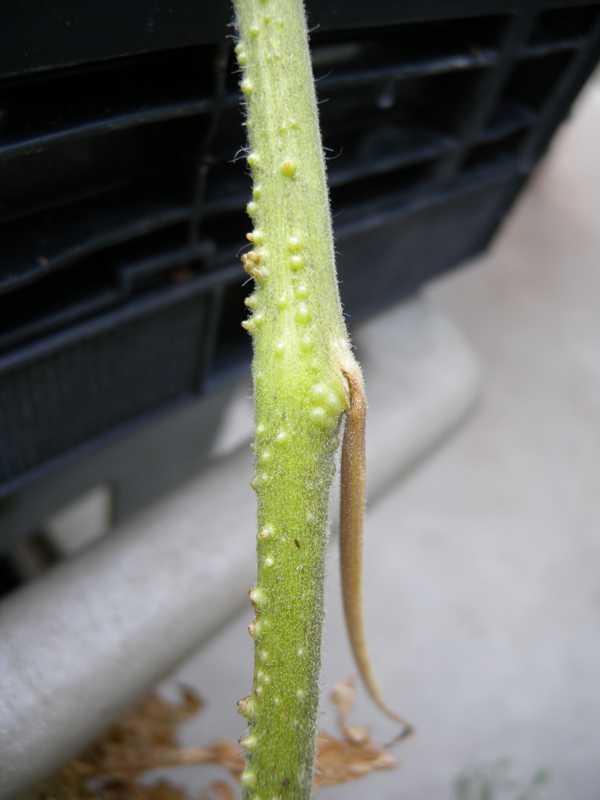 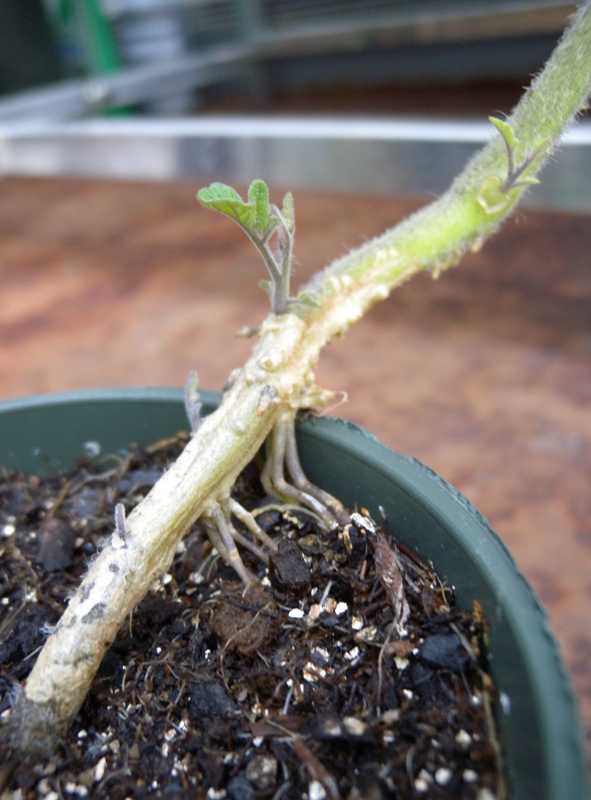 |
Root initiatives on stem
Tomatoes can root along the stem and often do. This produces small bumps or root initiatives along the stem. This is not a problem. Instead it can be used to enlarge the root system and therefore the potential health of a plant. Dig a short trench for each plant and lay them in the trench on their sides, then cover them with soil. Be sure to mark the buried end to avoid accidentally injuring the plant when cultivating.
Lookalikes: Some gardeners mistake this for insects or disease |
|
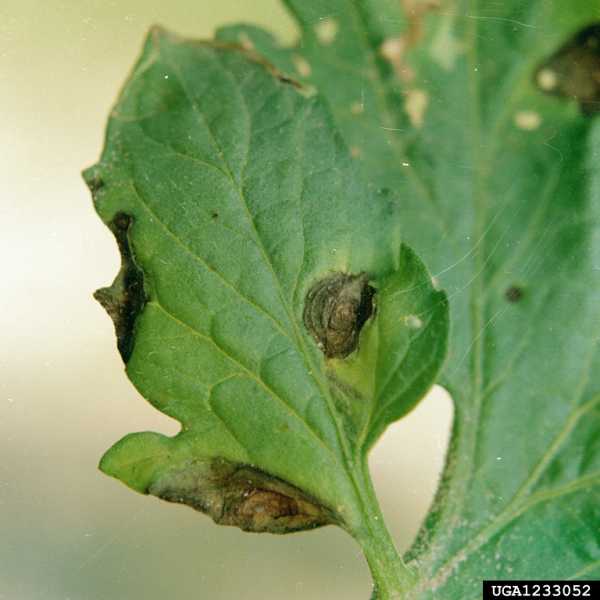
Clemson U-USDA CES
Slide Series, Bugwood.org
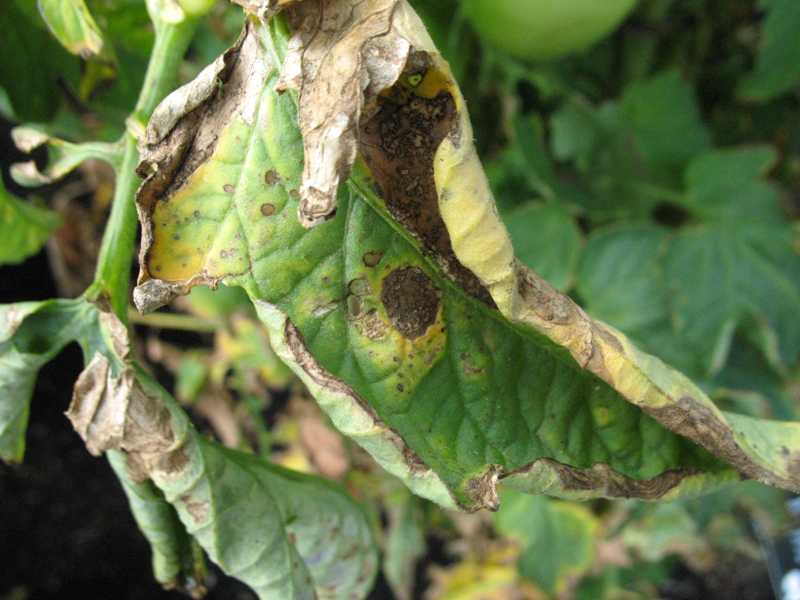
|
Early blight
The appearance of circular or irregular dark spots on the lower, more mature leaves is one of the first symptoms of this fungal disease. Eventually, the spots enlarge into a series of concentric rings surrounded by a yellow area. The entire leaf may be killed and will drop off the plant. The infection typically progresses from the base of the plant, upward. Early blight can result in extensive defoliation, exposing fruit to sunscald and reducing yields.
Lookalikes: other leaf spot diseases and other diseases that progress from the bottom up; such as, septoria leaf spot, fusarium wilt, verticillium wilt |
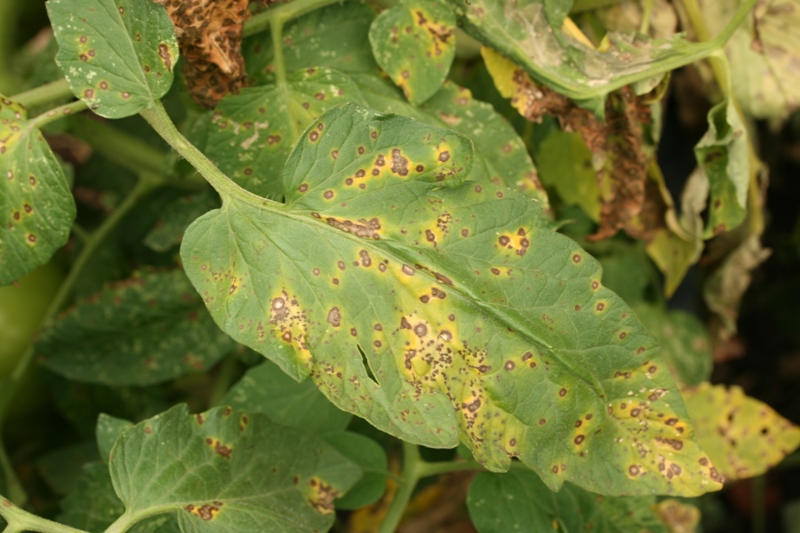 |
Septoria leaf spot
Septoria leaf spot usually appears on the lower leaves after the first fruit sets. Spots are circular, about one-sixteenth to one-fourth inch in diameter with dark brown margins and tan to gray centers with small black fruiting structures. Characteristically, there are many spots per leaf; they do not look target-like. This disease spreads upwards from oldest to youngest growth. If leaf lesions are numerous, the leaves turn slightly yellow, then brown, and then wither. Fruit infection is rare.
Lookalikes: bacterial leaf spot and speck (no tan centers); and other diseases that progress from the bottom up |
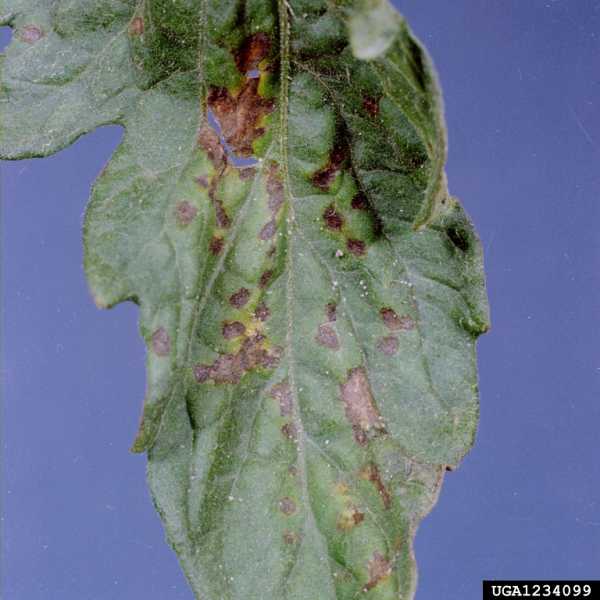
Clemson U - USDA CES Slide Series, Bugwood.org |
Bacterial spot and speck
These are two separate but very similar diseases. Symptoms of bacterial spot are small dark brown to black circular spots, initially water-soaked, coalescing and becoming angular, sometimes with a yellow halo. Symptoms of bacterial speck are tiny, dark brown to black spots with a surrounding yellow halo. Severity of both diseases is increased by wetness of fruit and foliage from sprinklers, rain, or heavy dew. There are some tomato varieties with resistance to bacterial speck but very few with resistance to bacterial spot.
Lookalikes: Septoria leaf spot (tan centers) |
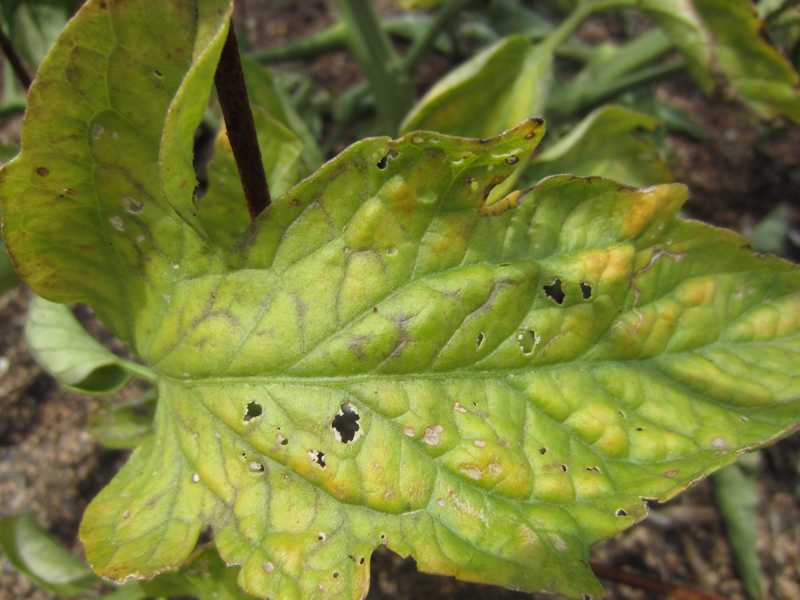 |
Iron chlorosis
Chlorosis or yellowing of leaves can have many causes, including many diseases, nutrient deficiencies, piercing-sucking insect or mite damage and various environmental problems, such as, too much water and improper soil pH. Tomatoes prefer slightly acid soil with a pH between 6.2 and 6.8 although they will tolerate a wider pH range if the soil is well drained and contains adequate organic matter. |
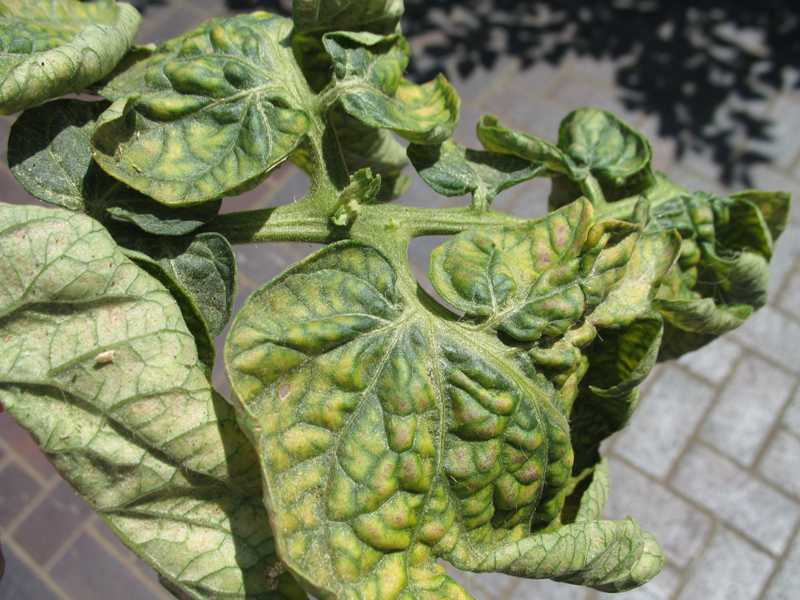 |
Spider mites
Infestations of spider mites result in the bleaching and stippling of leaves. Severe infestations may cause entire leaves to become bronzed, curled, and completely enveloped in sheets of fine webbing. Damage to the foliage may result in leaf drop and reduction in the overall vitality of the plant.
Lookalikes: drought stress, herbicide injury, physiological leaf roll, viral diseases, iron chlorosis |
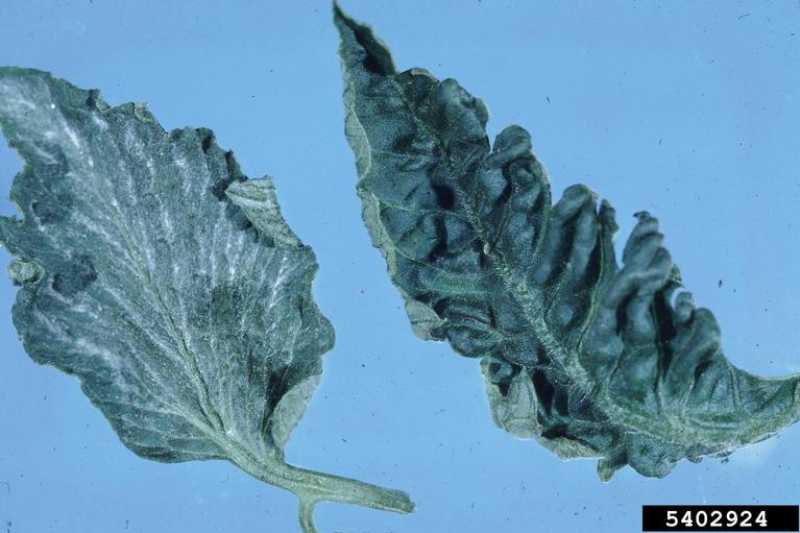
R.W. Samson, Purdue University, Bugwood.org |
Herbicide injury
Depending on the herbicide used, symptoms can include one or more of the following: curling (from 2, 4-D on the right), cupping, stunted growth, discolored leaves, leaves with dead spots, and strapping, a.k.a., parallel venation (from 2,4-D on the left).
Lookalikes: drought stress, spider mites, physiological leaf roll, viral diseases |
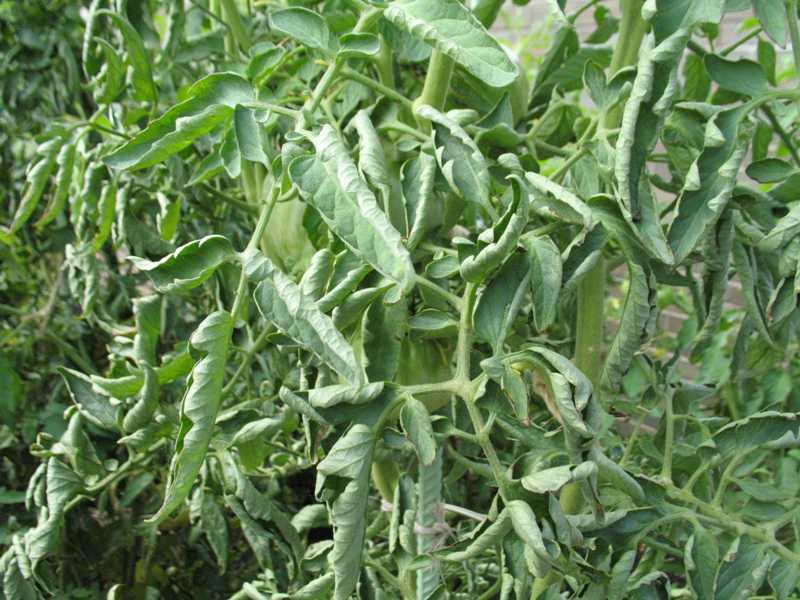 |
Physiological leaf roll
Physiological leaf roll on some tomato cultivars is normal and not harmful. It can also be a temporary condition caused by weather conditions or by an inconsistent supply of moisture. Lack of other symptoms (yellowing, parallel veination, lack of vigor, stunting, etc.) distinguishes it from its lookalikes.
Lookalikes: drought stress, spider mites, herbicide injury, some viral diseases |
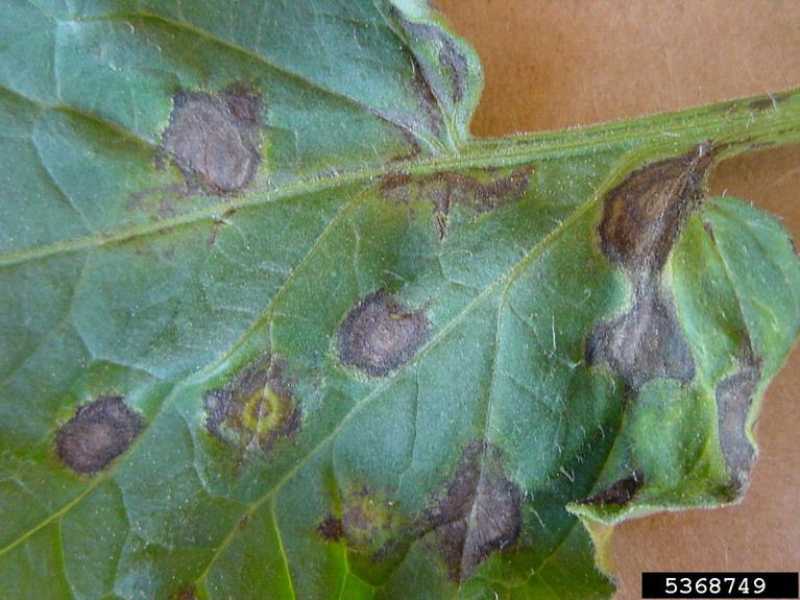
P. Bachi, UKY Research & Ed. Ctr, Bugwood.org
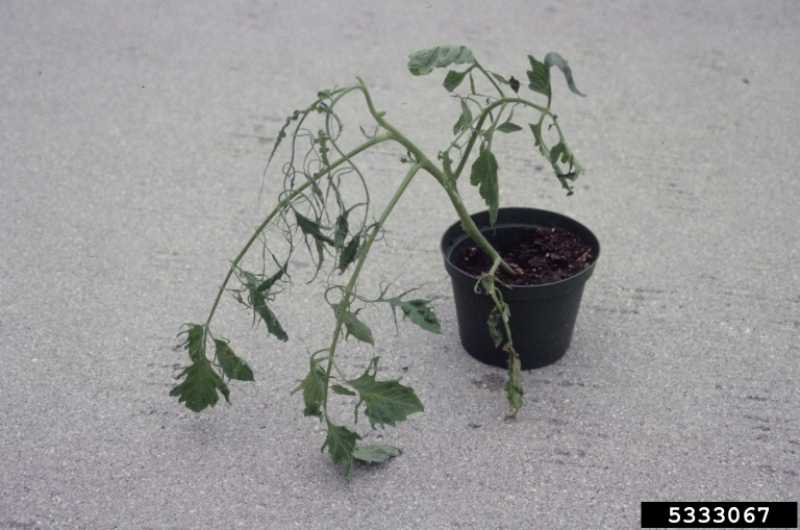
M. A. Hansen, VPISU, Bugwood.org |
Viruses
Many viruses affect tomatoes, such as, tomato spotted wilt virus (top image), tobacco mosaic virus (bottom image), cucumber mosaic, etc. Symptoms include leaf distortion, mosaic, mottling, ring spots, leaf curl, threadlike foliage and stunting.
Lookalikes: drought stress, herbicide injury, physiological leaf roll, spider mites, foliar diseases |
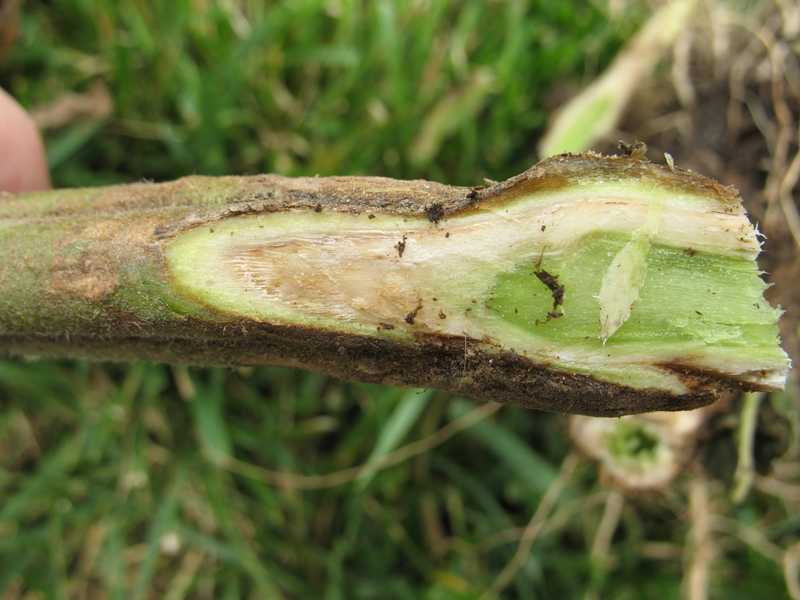
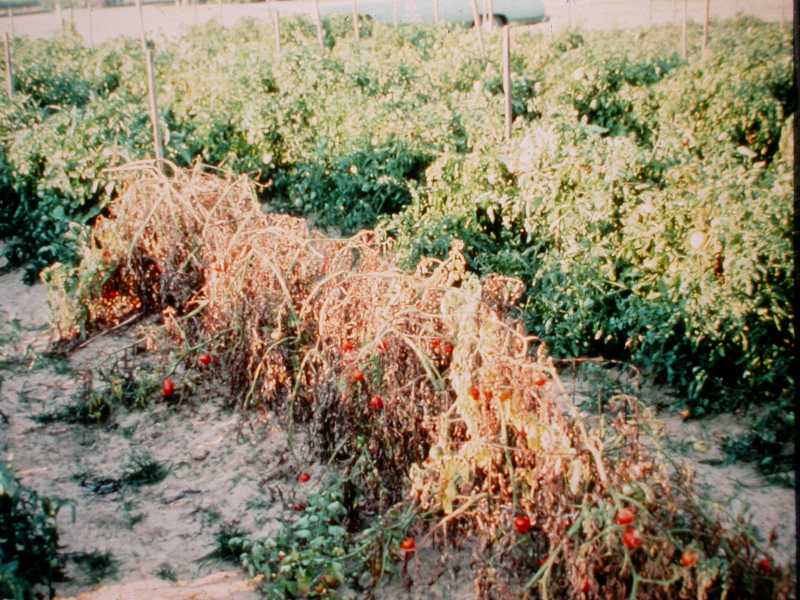 |
Fusarium & verticillium wilts
Both of these fungal diseases are soil-born. Fusarium often causes yellowing on one side of the plant or leaf. Yellowing begins with the older, bottom leaves, followed by wilting, browning, and defoliation. Growth is typically stunted, and little or no fruit develops. Brown, vascular tissue can be found when the infected stem is cut at its base (top image). Infected plants often die before maturing (bottom image).
Verticillium is less common, usually occurring late in the season when soils are cooler. It begins as a v-shaped blotch on lower leaves, followed by browning veins and dead, chocolate brown blotches. It spreads up the plant. Discoloration of the vascular tissue is limited to the bottom 12 inches of the stem. Look for tomatoes with the resistance letters VF on the plant tag or seed packet, indicating resistance to both verticillium and fusarium wilt.
Lookalikes: all the leaf spot diseases and “bottom-up” diseases |
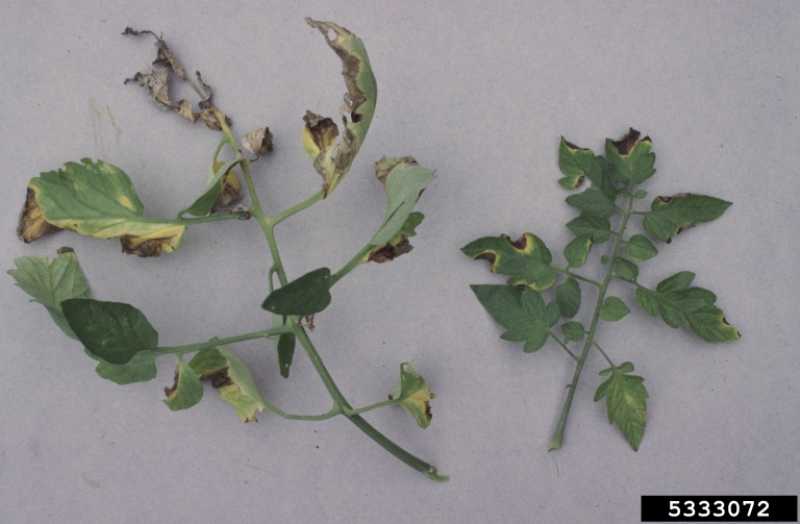
M. A Hansen, VPISU, Bugwood.org
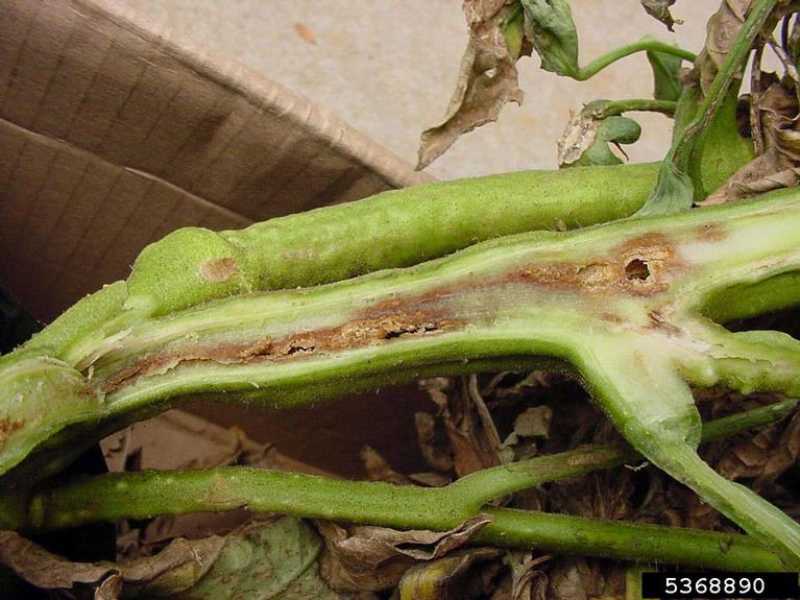
P. Bachi, UKY Research & Ed. Ctr., Bugwood.org |
Bacterial canker
The symptoms of bacterial canker are brown leaf margins with a yellow border next to the inner green leaf tissue, spreading between the veins (top image). It often affects only one side of a plant. As plants wilt, yellowing leaves usually remain attached to the plant. Unlike the leaves, the petioles remain green. The vascular system shows a yellowish brown discoloration (bottom image). This is a serious infectious disease with no cure and no resistant varieties available. It will kill the plant and is highly infectious, easily spreading to other plants. Infected plants should be removed from the garden immediately and extensive measures implemented for disinfection.
Lookalikes: other foliar diseases, particularly fusarium wilt, viruses |
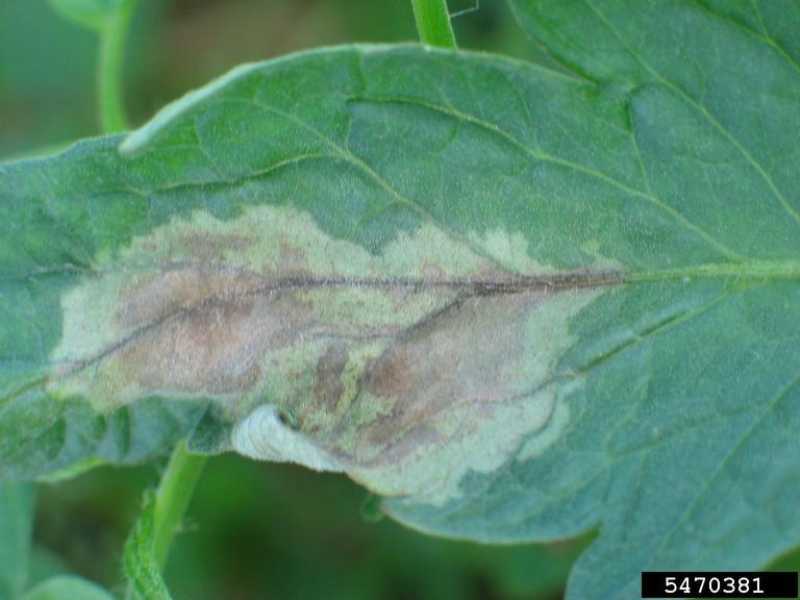
M. McGrath, Cornell U., Bugwood.org
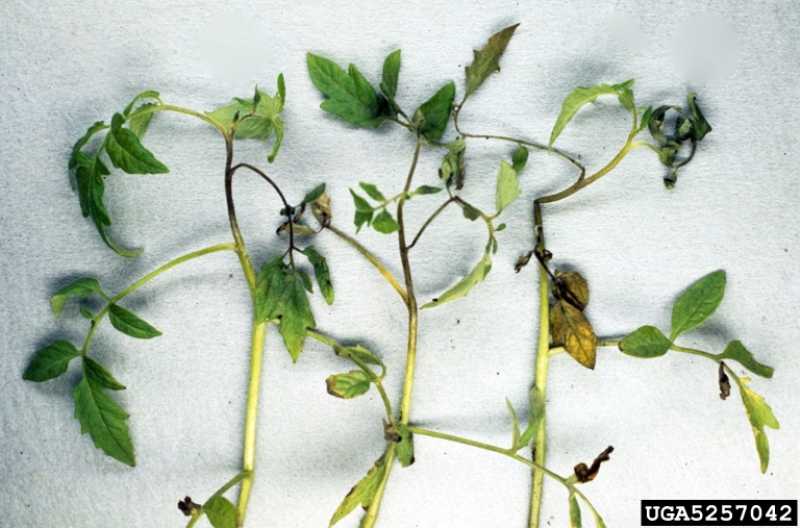
FL DPI Archive, FDACS, Bugwood.org |
Late Blight
Late blight is a fungal disease that attacks the older leaves first, then spreads to the fruit. Green-black watery patches develop on the upper surfaces of older leaves. These patches will enlarge quickly, and in moist weather, a downy growth may develop on the underside of the leaf.
Lookalikes: other “bottom-up” diseases |
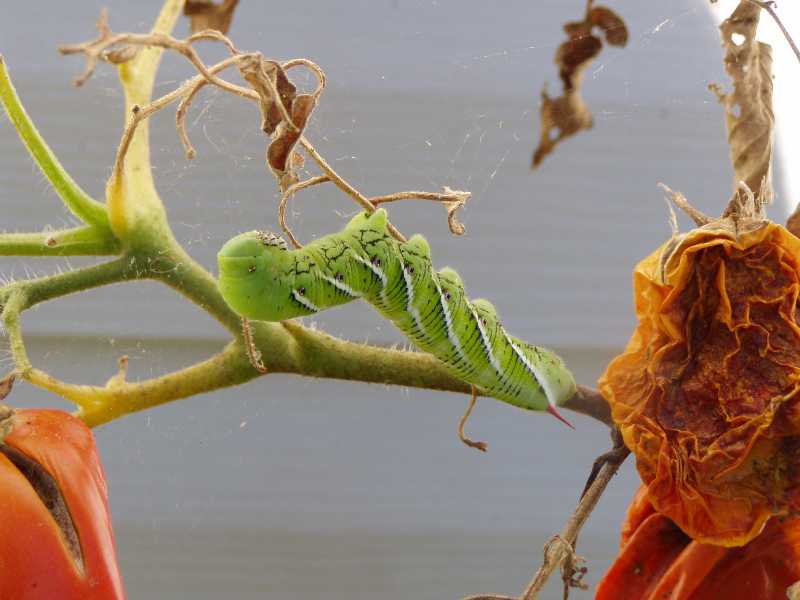
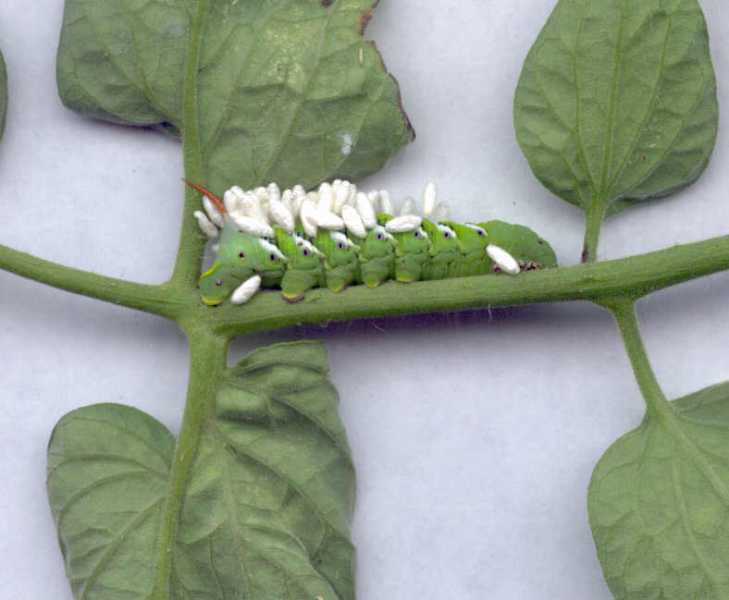 |
Hornworms
Hornworms are the larval stage (caterpillars) of sphinx moths. They are called hornworms because of the tell-tale horn or spike on their tail end (top image). These caterpillars have voracious appetites and can consume entire leaves and small stems in a short time. Hornworm damage is obvious when the infestation is moderate to heavy because of the large amount of defoliation. Search for the large caterpillars and the large, black droppings on the leaves or ground beneath the plant.
Hornworms that are not feeding should be left on the tomato plant. They may have been infected with Bt, an organic pesticide that only attacks caterpillars, or they may have been parasitized (bottom image). The tiny white cocoons sprouting from the hornworm are the pupal cases of tiny wasps that have eaten the hornworm from the inside out. If left alone, the adults will emerge and fly off in search of other caterpillars to parasitize and kill. |
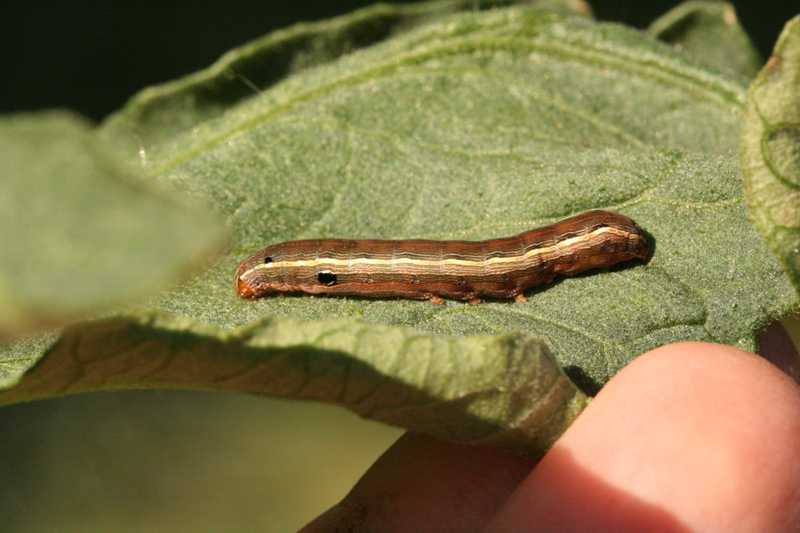 |
Other leaf and plant chewers
Tomatoes are hosts to many caterpillars, such as, this cankerworm (yellow-striped army worm), as well as, raccoons and deer, which will eat both tomato plants and fruit. |
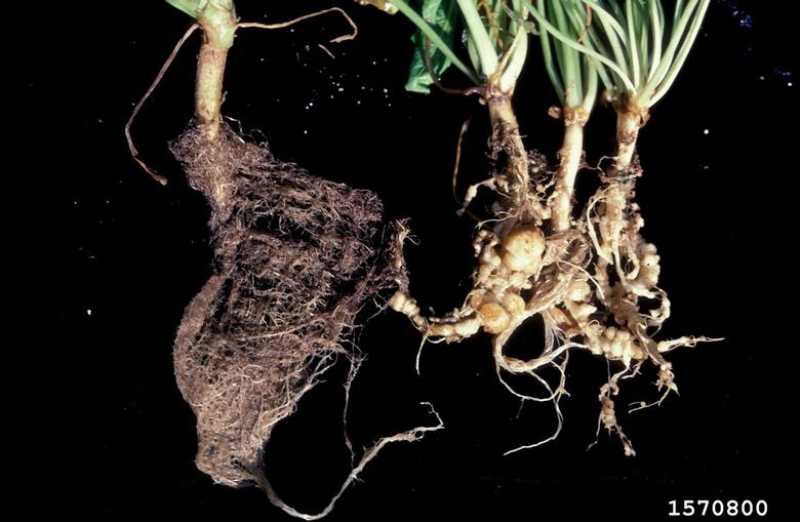
G. Holmes, Valent USA Corp., Bugwood.org |
Root-knot Nematodes
Healthy tomato (left). Tomato infected with root-knot nematodes (right). This is usually only a problem in sandy soils, which are rare in the St. Louis area.
Lookalikes: drought stress, nutritional deficiencies |
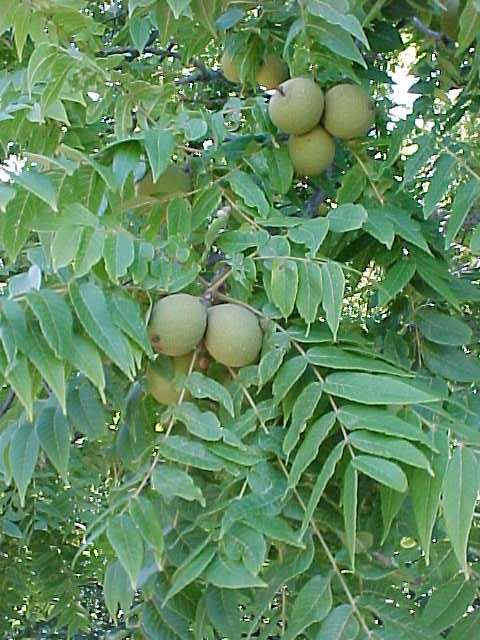 |
Allelopathy
Roots are inhibited by the presence of a chemical released by another plant, such as, a black walnut. Tomatoes should not be planted within 50 feet of the drip line of a black walnut. |
| |
Last updated: 6/2012 View a pdf of this guide |